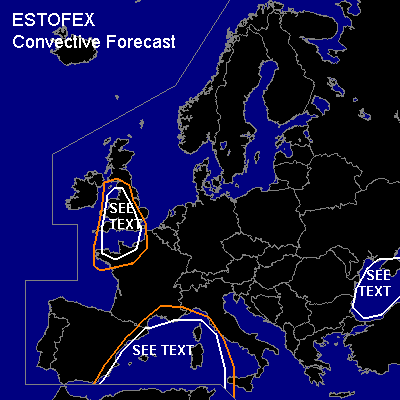

CONVECTIVE FORECAST
VALID Sun 16 Oct 06:00 - Mon 17 Oct 06:00 2005 (UTC)
ISSUED: 15 Oct 22:02 (UTC)
FORECASTER: DAHL
SYNOPSIS
Omega block persists through the period ... with the two SW and SE European upper cut-off lows adjacent to the central ridge being replaced by more intense/large upstream upper lows: Iberian cut-off low is already in the process of being absorbed by extensive N-Atlantic upper low ... thereby accelerating north ... crossing WRN France and the British Isles until Monday morning. SE European upper low is FCST to merge with SWD moving upper low expected over the Baltic States/Belarus by Sunday 00Z. On Saturday evening ... plume of weakly unstable air has been present over the W Mediterranean and France as well as over the S/SE Mediterranean ... with rather cool/stable comditions prevailing elsewhere.
DISCUSSION
......
Isolated to scattered TSTMS should continue ahead of vort max which will cross the British Isles in the late afternoon and evening hours. Indications are that storms will be mainly elevated ... and that effective shear in the cloud-bearing layer will be rather weak. However ... SFC-based storms would benefit from rather strong LL and DL shear ... and an attendant threat for rotating updrafts would exist. But threat appears to be too slim for a SLGT.
...W Mediterranean...
Though large-scale forcing for UVVs should be minimal ... mesoscale circulation along thermal boundary over ther W Mediterranean as well as orographic forcing over the isles may support scattered TSTMS. LL thermodynamic parameters suggest that waterspouts may occur with any reasonably deep SFC-based convection.
...SE Europe...
It seems that activity associated with the residual upper low affecting S Turkey on Sunday will remain just outside the forecast area. Shallow TSTMS could form however near the approaching large-scale upper low center early Monday morning over the WRN Black Sea. Shear would be sufficient for small mesocyclones ... but confidence in widespread convective development is rather low ATTM.
#